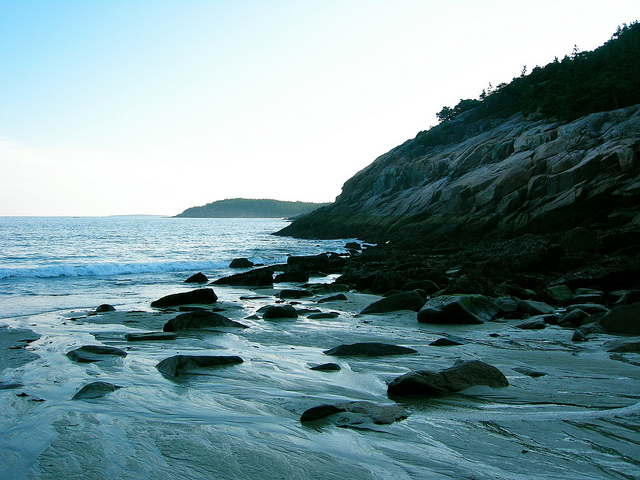
Sand Beach in Acadia National Park. Photo © Garden State Hiker, licensed Creative Commons Attribution.
The magnificent beauty of Maine’s shoreline comes thanks in part to the large tides that wash against it every day. To find some of the rarest treasures of the Maine coastline, try going tidepooling at the beautiful Acadia National Park. Here are some tips on how to work around the tides for the best chance of discovering some usually-submerged beauties.Nowhere is the adage “Time and tide wait for no one” more true than along the Maine coastline. The nation’s most extreme tidal ranges occur in Maine, and they become even more dramatic as you head “Down East,” toward the Canadian Maritime provinces. Every six hours or so, the tide begins either ebbing or flowing, so you’ll have countless opportunities for observing tidal phenomena.
The best time for shoreline exploration is on a new-moon or full-moon day, when low tide exposes mussels, sea urchins, sea cucumbers, sea stars, periwinkles, hermit crabs, rockweed, and assorted nonbiodegradable trash.Tides govern coastal life, and everyone is a slave to the tide calendar or chart, which coastal-community newspapers diligently publish in every issue. Each issue of the free Acadia Weekly, available widely on the island, also contains tide info (as well as times of sunrise and sunset), as does the Ranger-led Program Schedule issued by the park. In tidal regions, boats tie up with extra-long lines, clammers and worm-diggers schedule their days by the tides, hikers have to plan ahead for shoreline exploring, and kayakers need to plan their routes to avoid getting stuck in the muck.Average tidal ranges (between low tide and high tide) in the area around Acadia National Park are 10–11 feet, and extremes are 12–13 feet. Tides, as we all learned in elementary school, are lunar phenomena, created by the gravitational pull of the moon; the tidal range depends on the lunar phase.
Tides are most extreme at new and full moons—when the sun, moon, and earth are all aligned. These are spring tides, supposedly because the water springs upward (the term has nothing to do with the season). And tides are smallest during the moon’s first and third quarters—when the sun, earth, and moon have a right-angle configuration. These are neap tides (neap comes from an Old English word meaning “scanty”). Other lunar and solar phenomena, such as the equinoxes and solstices, can also affect tidal ranges.
The best time for shoreline exploration is on a new-moon or full-moon day, when low tide exposes mussels, sea urchins, sea cucumbers, sea stars, periwinkles, hermit crabs, rockweed, and assorted nonbiodegradable trash. Rubber boots or waterproof treaded shoes are essential on the wet, slippery terrain.
Caution is also essential in tidal areas. Unless you’ve carefully plotted tide times and heights, don’t park a car, bike, or boat trailer on a beach; make sure your sea kayak is lashed securely to a tree or bollard; don’t take a long nap on shoreline granite; and don’t cross a low tide land spit without an eye on your watch.
A perhaps apocryphal but almost believable story goes that one flatlander stormed up to a ranger at a Maine state park one bright summer morning and demanded indignantly to know why they had had the nerve to drain the water from her shorefront campsite during the night. When it comes to tides, you just have to go with the flow.
For current tide charts and more information on tidepooling in Acadia National Park, visit Acadia’s Tidepooling page×Excerpted from the Fourth Edition of Moon Acadia National Park.